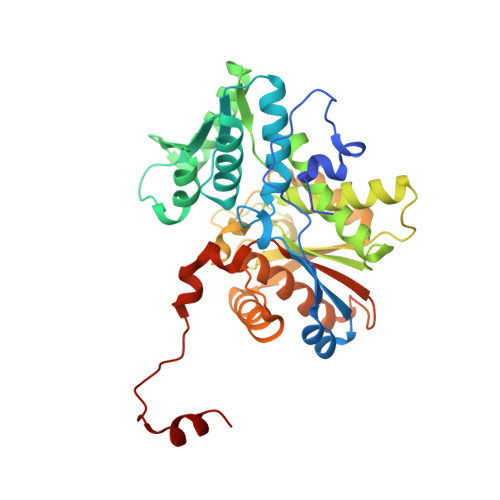Structural, biochemical, and in vivo investigations of the threonine synthase from Mycobacterium tuberculosis.
Covarrubias, A.S., Hogbom, M., Bergfors, T., Carroll, P., Mannerstedt, K., Oscarson, S., Parish, T., Jones, T.A., Mowbray, S.L.(2008) J Mol Biol 381: 622-633
- PubMed: 18621388
- DOI: https://doi.org/10.1016/j.jmb.2008.05.086
- Primary Citation of Related Structures:
2D1F - PubMed Abstract:
Threonine biosynthesis is a general feature of prokaryotes, eukaryotic microorganisms, and higher plants. Since mammals lack the appropriate synthetic machinery, instead obtaining the amino acid through their diet, the pathway is a potential focus for the development of novel antibiotics, antifungal agents, and herbicides. Threonine synthase (TS), a pyridoxal-5-phosphate-dependent enzyme, catalyzes the final step in the pathway, in which L-homoserine phosphate and water are converted into threonine and inorganic phosphate. In the present publication, we report structural and functional studies of Mycobacterium tuberculosis TS, the product of the rv1295 (thrC) gene. The structure gives new insights into the catalytic mechanism of TSs in general, specifically by suggesting the direct involvement of the phosphate moiety of the cofactor, rather than the inorganic phosphate product, in transferring a proton from C4' to C(gamma) in the formation of the alphabeta-unsaturated aldimine. It further provides a basis for understanding why this enzyme has a higher pH optimum than has been reported elsewhere for TSs and gives rise to the prediction that the equivalent enzyme from Thermus thermophilus will exhibit similar behavior. A deletion of the relevant gene generated a strain of M. tuberculosis that requires threonine for growth; such auxotrophic strains are frequently attenuated in vivo, indicating that TS is a potential drug target in this organism.
Organizational Affiliation:
Department of Cell and Molecular Biology, Uppsala University, SE-751 24 Uppsala, Sweden.















